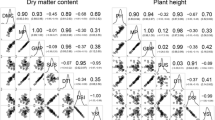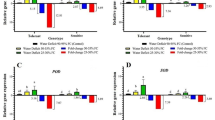Abstract
Cassava (Manihot esculenta) is a staple food crop mostly grown in the tropics. Successful cultivation in marginal areas derives from its ability to withstand difficult environmental conditions. Aiming at providing new insights into drought tolerance in Manihot spp., we performed physiological and molecular analyses of early drought response in three cassava varieties and in the wild species, Manihot glaziovii (maniçoba). Plants grown in pots were subjected to three water regimes for 5 days, based on soil field capacity (FC): 75% (well-watered plants); 45% (moderately stressed plants), and 20% (severely stressed plants), under greenhouse condition. Analysis of leaf gas exchange showed a downward trend in photosynthesis, stomatal conductance, and transpiration, with intensification of the stress, in all genotypes, being significantly reduced only at 20% FC. Maniçoba stood out for maintaining a positive carbon balance in severe stress condition via stomatal aperture control. Photoinhibition of the photosystem II by drought was also evident only at 20% FC. There was no clear association between proline accumulation and drought stress tolerance. Expression analysis of nine genes encoding heat-shock proteins, transcription factors, a cell redox homeostasis protein, and a no-hit protein confirmed the activation of classical stress-responsive pathways, especially those involved in oxidative damage avoidance. These results reinforce the intrinsic drought tolerance of cassava, highlight the superior performance of maniçoba under water deficit conditions, and give insights into drought phenoty** in cassava and contribute to further development of functional molecular markers to be used in assisted breeding.




Similar content being viewed by others
References
Aglawe SB, Fakrudin B, Patole CB et al (2012) Quantitative RT-PCR analysis of 20 transcription factor genes of MADS, ARF, HAP2, MBF and HB families in moisture stressed shoot and root tissues of sorghum. Physiol Mol Biol Plants 18:287–300. https://doi.org/10.1007/s12298-012-0135-5
Alves AAC, Setter TL (2004) Abscisic acid accumulation and osmotic adjustment in cassava under water deficit. Environ Exp Bot 51:259–271. https://doi.org/10.1007/s12298-012-0135-510.1016/j.envexpbot.2003.11.005
Barrs HD, Weatherley P (1962) A re-examination of the relative turgidity technique for estimating water deficits in leaves. Aust J Biol Sci 15:413–428
Bates LS, Waldren RP, Teare ID (1973) Rapid determination of free proline for water-stress studies. Plant Soil 39:205–207
Beltrán J, Jaimes H, Echeverry M et al (2009) Quantitative analysis of transgenes in cassava plants using real-time PCR technology. Vitr Cell Dev Biol - Plant 45:48–56. https://doi.org/10.1007/s12298-012-0135-510.1007/s11627-008-9159-5
Betti M, Pérez-Delgado C, García-Calderón M et al (2012) Cellular stress following water deprivation in the model legume Lotus japonicus. Cells 1:1089–1106. https://doi.org/10.1007/s12298-012-0135-510.3390/cells1041089
Cakmak I, Horst WJ (1991) Effect of aluminium on lipid peroxidation, superoxide dismutase, catalase, and peroxidase activities in root tips of soybean (Glycine max). Physiol Plant 83:463–468
Calatayud P-A, Llovera E, Bois JF, Lamaze T (2000) Photosynthesis in drought-adapted Cassava. Photosynthetica 38:97–104. https://doi.org/10.1007/s12298-012-0135-510.1023/A:1026704226276
de Oliveira EJ, de Aidar S, Morgante CV et al (2015) Genetic parameters for drought-tolerance in cassava. Pesqui Agropecu Bras 50:233–241. https://doi.org/10.1007/s12298-012-0135-510.1590/S0100-204X2015000300007
de Oliveira EJ, Morgante CV, de Tarso AS et al (2017) Evaluation of cassava germplasm for drought tolerance under field conditions. Euphytica 213:188. https://doi.org/10.1007/s12298-012-0135-510.1007/s10681-017-1972-7
de Souza AP, Massenburg LN, Jaiswal D et al (2017) Rooting for cassava: insights into photosynthesis and associated physiology as a route to improve yield potential. New Phytol 213:50–65. https://doi.org/10.1007/s12298-012-0135-510.1111/nph.14250
El-Sharkawy MA (2007) Physiological characteristics of cassava tolerance to prolonged drought in the tropics: implications for breeding cultivars adapted to seasonally dry and semiarid environments. Braz J Plant Physiol. 19:257–286
El-Sharkawy MA (2004) Cassava biology and physiology. Plant Mol Biol 56:481–501. https://doi.org/10.1007/s11103-005-2270-7
El-Sharkawy MA, Cock JH, de Cadena G (1984) Stomatal characteristics among cassava cultivars and their relation to gas exchange. Exp Agric 20:67–76
El-Sharkawy MA, Cock JH, Del Pilar HA (1985) Stomatal response to air humidity and its relation to stomatal density in a wide range of warm climate species. Photosynth Res 7:137–149. https://doi.org/10.1007/BF00037004
FAO (2014) Faostat—Food and Agriculture Organization of the United Nations statistics database
Ferreira EB, Cavalcanti, PP, Nogueira DA (2018) ExPDes: Experimental Design. R Package version 1.2.0. https://cran.r-project.org/web/packages/ExpDes. Accessed 21 May 2018
Fu L, Ding Z, Han B et al (2016) Physiological investigation and transcriptome analysis of polyethylene glycol (PEG)-induced dehydration stress in cassava. Int J Mol Sci 17:283. https://doi.org/10.3390/ijms17030283
Jacob P, Hirt H, Bendahmane A (2017) The heat-shock protein/chaperone network and multiple stress resistance. Plant Biotechnol J 15:405–414. https://doi.org/10.1111/pbi.12659
Jahns P, Holzwarth AR (2012) The role of the xanthophyll cycle and of lutein in photoprotection of photosystem II. Biochim Biophys Acta Bioenerg 1817:182–193. https://doi.org/10.1016/j.bbabio.2011.04.012
Kaur G, Asthir B (2017) Molecular responses to drought stress in plants. Biol Plant 61:201–209. https://doi.org/10.1007/s10535-016-0700-9
Khong GN, Pati PK, Richaud F et al (2015) OsMADS26 negatively regulates resistance to pathogens and drought tolerance in rice. Plant Physiol 169:2935–2949. https://doi.org/10.1104/pp.15.01192
Kneeshaw S, Keyani R, Delorme-hinoux V et al (2017) Nucleoredoxin guards against oxidative stress by protecting antioxidant enzymes. Proc Natl Acad Sci 114:8414–8419. https://doi.org/10.1073/pnas.1703344114
Li S, Yu X, Cheng Z et al (2017) Global gene expression analysis reveals crosstalk between response mechanisms to cold and drought stresses in cassava seedlings. Front Plant Sci 8:1259. https://doi.org/10.3389/fpls.2017.01259
Livak KJ, Schmittgen TD (2001) Analysis of relative gene expression data using real-time quantitative PCR and the 2−ΔΔCT method. Methods 25:402–408. https://doi.org/10.1006/METH.2001.1262
Lokko Y, Anderson JV, Rudd S et al (2007) Characterization of an 18,166 EST dataset for cassava (Manihot esculenta Crantz) enriched for drought-responsive genes. Plant Cell Rep 26:1605–1618. https://doi.org/10.1007/s00299-007-0378-8
Mendiburu F (2019) Agricolae: Statistical Procedures for Agricultural Research. R Package version 1.3-1. https://cran.r-project.org/web/packages/agricolae/. Accessed 21 May 2018
Moore S, Stein W (1948) Photometric ninhydrin method for use in the chromatography of amino acids. J Biol Chem 176:367–388
Morgante CV, Guimarães PM, Martins ACQ et al (2011) Reference genes for quantitative reverse transcription-polymerase chain reaction expression studies in wild and cultivated peanut. BMC Res Notes. https://doi.org/10.1186/1756-0500-4-339
Nassar NM, Abreu LF, Teodoro DAP, Graciano-Ribeiro D (2010) Drought tolerant stem anatomy characteristics in Manihot esculenta (Euphorbiaceae) and a wild relative. Genet Mol Res 9:1023–1031. https://doi.org/10.4238/vol9-2gmr800
Nassar NMA (2000) Wild cassava, Manihot spp.: biology and potentialities for genetic improvement. Genet Mol Biol 23:201–212. https://doi.org/10.1590/S1415-47572000000100035
Okogbenin E, Setter TL, Ferguson M et al (2013) Phenotypic approaches to drought in cassava : review. Front Physiol 4:1–16. https://doi.org/10.3389/fphys.2013.00093
Pereira LFM, Zanetti S, de Silva M (2017) Water relations of cassava cultivated under water-deficit levels. Acta Physiol Plant 40:13. https://doi.org/10.1007/s11738-017-2590-7
Pfaffl MW, Horgan GW, Dempfle L (2002) Relative expression software tool (REST (c)) for group-wise comparison and statistical analysis of relative expression results in real-time PCR. Nucleic Acids Res. https://doi.org/10.1093/nar/30.9.e36
Ren MY, Feng RJ, Shi HR et al (2017) Expression patterns of members of the ethylene signaling–related gene families in response to dehydration stresses in cassava. PLoS ONE ONE 12:1–24. https://doi.org/10.1371/journal.pone.0177621
Rizhsky L, Liang H, Shuman J et al (2004) When defense pathways collide. The response of Arabidopsis to a combination of drought and heat stress. Plant Physiol 134:1683–1696. https://doi.org/10.1104/pp.103.033431.1
Sakamoto H, Maruyama K, Sakuma Y et al (2004) Arabidopsis Cys2/His2-type zinc-finger proteins function as transcription repressors under drought, cold, and high-salinity stress conditions. Plant Physiol 136:2734–2746. https://doi.org/10.1104/pp.104.046599.2734
Shan Z, Luo X, Wei M et al (2018) Physiological and proteomic analysis on long-term drought resistance of cassava (Manihot esculenta Crantz). Sci Rep 8:1–12. https://doi.org/10.1038/s41598-018-35711-x
Sundaresan S, Sudhakaran PR (1995) Water stress-induced alterations in the proline metabolism of drought-susceptible and -tolerant cassava (Manihot esculenta) cultivars. Physiol Plant 94:635–642. https://doi.org/10.1111/j.1399-3054.1995.tb00978.x
Szabados L, Savoure A (2009) Proline: a multifunctional amino acid. Trends Plant Sci 15:89–97. https://doi.org/10.1016/j.tplants.2009.11.009
Turyagyenda LF, Kizito EB, Ferguson M et al (2013) Physiological and molecular characterization of drought responses and identification of candidate tolerance genes in cassava. AOB Plants 5:7. https://doi.org/10.1093/aobpla/plt007
Untergasser A, Cutcutache I, Koressaar T et al (2012) Primer3-new capabilities and interfaces. Nucleic Acids Res 40:1–12. https://doi.org/10.1093/nar/gks596
van Kooten O, Snel JFH (1990) The use of chlorophyll fluorescence nomenclature in plant stress physiology. Photosynth Res 25:147–150. https://doi.org/10.1007/BF00033156
Wang B, Guo X, Zhao P et al (2017) Molecular diversity analysis, drought related marker-traits association map** and discovery of excellent alleles for 100-day old plants by EST-SSRs in cassava germplasms (Manihot esculenta Cranz). PLoS ONE One 12:e0177456. https://doi.org/10.1371/journal.pone.0177456
Wang D, Pan Y, Zhao X et al (2011) Genome-wide temporal-spatial gene expression profiling of drought responsiveness in rice. BMC Genom 12:149. https://doi.org/10.1186/1471-2164-12-149
Wang W, Vinocur B, Shoseyov O, Altman A (2004) Role of plant heat-shock proteins and molecular chaperones in the abiotic stress response. Trends Plant Sci 9:244–252. https://doi.org/10.1016/j.tplants.2004.03.006
Yang J, An D, Zhang P (2011) Expression profiling of cassava storage roots reveals an active process of glycolysis/gluconeogenesis. J Integr Plant Biol 53:193–211. https://doi.org/10.1111/j.1744-7909.2010.01018.x
Yin M, Wang Y, Zhang L et al (2017) The Arabidopsis Cys2/His2 zinc finger transcription factor ZAT18 is a positive regulator of plant tolerance to drought stress. J Exp Bot 68:2991–3005. https://doi.org/10.1093/jxb/erx157
Yu X, James AT, Yang A et al (2016) A comparative proteomic study of drought-tolerant and drought-sensitive soybean seedlings under drought stress. Crop Pasture Sci 67:528–540. https://doi.org/10.1071/CP15314
Zhang D, Tong J, Xu Z et al (2016) Soybean C2H2-type zinc finger protein GmZFP3 with conserved QALGGH motif negatively regulates drought responses in transgenic Arabidopsis. Front Plant Sci 7:325. https://doi.org/10.3389/fpls.2016.00325
Zhao L, Ding Q, Zeng J et al (2012) An improved CTAB—ammonium acetate method for total RNA isolation from cotton. Phytochem Anal 23:647–650. https://doi.org/10.1002/pca.2368
Zhao S, Fernald RD (2005) Comprehensive algorithm for quantitative real-time polymerase chain reaction. J Comput Biol 12:1047–1064. https://doi.org/10.1089/cmb.2005.12.1047
Acknowledgements
The authors thank the Fundação de Amparo à Pesquisa do Estado da Bahia (FAPESB), Coordenação de Aperfeiçoamento de Pessoal de Nível Superior (CAPES), and Conselho Nacional de Desenvolvimento Científico e Tecnológico (CNPq) for the financial assistance and scholarship support.
Author information
Authors and Affiliations
Corresponding author
Ethics declarations
Conflict of interest
The authors declare that they have no conflict of interest.
Additional information
Communicated by J. Kovacik.
Publisher's Note
Springer Nature remains neutral with regard to jurisdictional claims in published maps and institutional affiliations.
Electronic supplementary material
Below is the link to the electronic supplementary material.
Rights and permissions
About this article
Cite this article
Morgante, C.V., Nunes, S.P., Chaves, A.R. et al. Genetic and physiological analysis of early drought response in Manihot esculenta and its wild relative. Acta Physiol Plant 42, 22 (2020). https://doi.org/10.1007/s11738-019-3005-8
Received:
Revised:
Accepted:
Published:
DOI: https://doi.org/10.1007/s11738-019-3005-8




